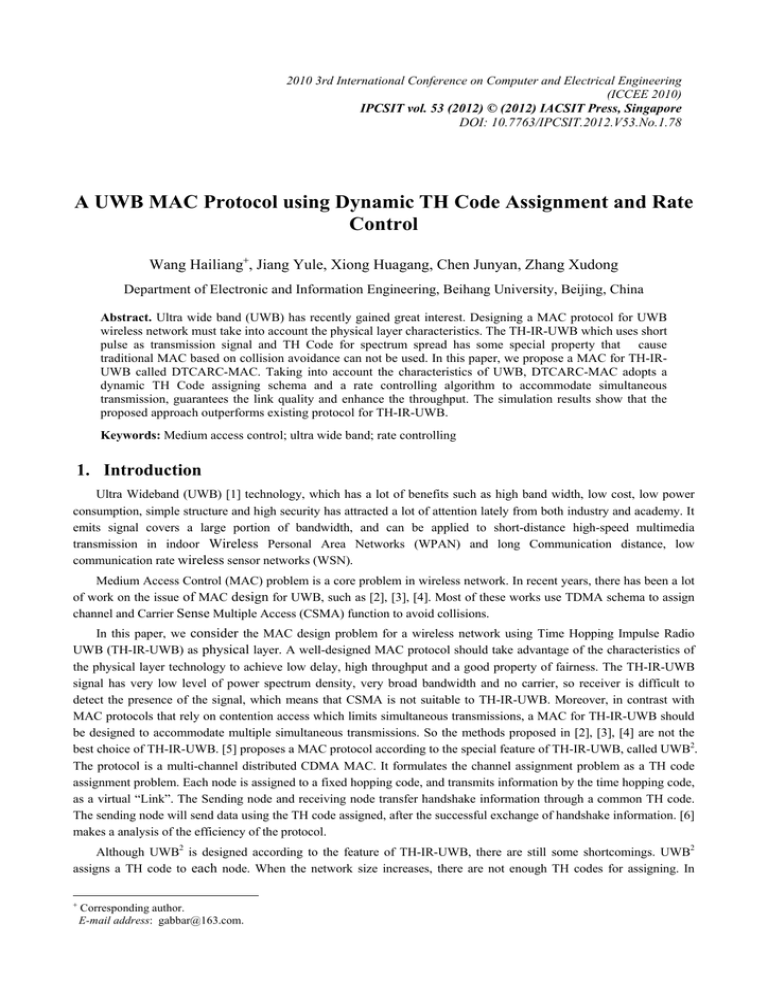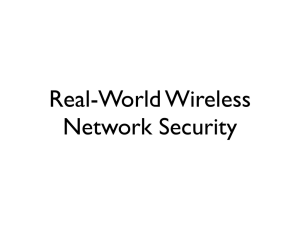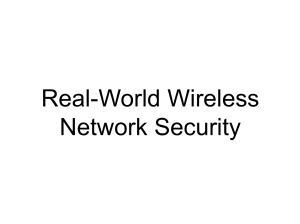Document 13136198
advertisement

2010 3rd International Conference on Computer and Electrical Engineering
(ICCEE 2010)
IPCSIT vol. 53 (2012) © (2012) IACSIT Press, Singapore
DOI: 10.7763/IPCSIT.2012.V53.No.1.78
A UWB MAC Protocol using Dynamic TH Code Assignment and Rate
Control
Wang Hailiang+, Jiang Yule, Xiong Huagang, Chen Junyan, Zhang Xudong
Department of Electronic and Information Engineering, Beihang University, Beijing, China
Abstract. Ultra wide band (UWB) has recently gained great interest. Designing a MAC protocol for UWB
wireless network must take into account the physical layer characteristics. The TH-IR-UWB which uses short
pulse as transmission signal and TH Code for spectrum spread has some special property that cause
traditional MAC based on collision avoidance can not be used. In this paper, we propose a MAC for TH-IRUWB called DTCARC-MAC. Taking into account the characteristics of UWB, DTCARC-MAC adopts a
dynamic TH Code assigning schema and a rate controlling algorithm to accommodate simultaneous
transmission, guarantees the link quality and enhance the throughput. The simulation results show that the
proposed approach outperforms existing protocol for TH-IR-UWB.
Keywords: Medium access control; ultra wide band; rate controlling
1. Introduction
Ultra Wideband (UWB) [1] technology, which has a lot of benefits such as high band width, low cost, low power
consumption, simple structure and high security has attracted a lot of attention lately from both industry and academy. It
emits signal covers a large portion of bandwidth, and can be applied to short-distance high-speed multimedia
transmission in indoor Wireless Personal Area Networks (WPAN) and long Communication distance, low
communication rate wireless sensor networks (WSN).
Medium Access Control (MAC) problem is a core problem in wireless network. In recent years, there has been a lot
of work on the issue of MAC design for UWB, such as [2], [3], [4]. Most of these works use TDMA schema to assign
channel and Carrier Sense Multiple Access (CSMA) function to avoid collisions.
In this paper, we consider the MAC design problem for a wireless network using Time Hopping Impulse Radio
UWB (TH-IR-UWB) as physical layer. A well-designed MAC protocol should take advantage of the characteristics of
the physical layer technology to achieve low delay, high throughput and a good property of fairness. The TH-IR-UWB
signal has very low level of power spectrum density, very broad bandwidth and no carrier, so receiver is difficult to
detect the presence of the signal, which means that CSMA is not suitable to TH-IR-UWB. Moreover, in contrast with
MAC protocols that rely on contention access which limits simultaneous transmissions, a MAC for TH-IR-UWB should
be designed to accommodate multiple simultaneous transmissions. So the methods proposed in [2], [3], [4] are not the
best choice of TH-IR-UWB. [5] proposes a MAC protocol according to the special feature of TH-IR-UWB, called UWB2.
The protocol is a multi-channel distributed CDMA MAC. It formulates the channel assignment problem as a TH code
assignment problem. Each node is assigned to a fixed hopping code, and transmits information by the time hopping code,
as a virtual “Link”. The Sending node and receiving node transfer handshake information through a common TH code.
The sending node will send data using the TH code assigned, after the successful exchange of handshake information. [6]
makes a analysis of the efficiency of the protocol.
Although UWB2 is designed according to the feature of TH-IR-UWB, there are still some shortcomings. UWB2
assigns a TH code to each node. When the network size increases, there are not enough TH codes for assigning. In
+
Corresponding author.
E-mail address: gabbar@163.com.
addition, the UWB2 protocol doesn’t provide an effective method to suppress the Multi-User Interference (MUI). When
the network load is high, the MUI is severe, which makes error rate of each link dramatically increase. For the above
shortcomings of UWB2, we propose a UWB MAC Protocol using Dynamic TH Code Assignment and Rate Control
(DTCARC-MAC) on the basis of UWB2. Using this MAC, more users can be supported using limited number of TH
codes, and optimal throughput can be archived while ensuring the transmission error rate of each link.
The paper is organized as follows. In section II, the TH-IR-UWB signal model is introduced. The MAC description
is then detailed in Section III. In section IV, simulation results are provided. Finally, a conclusion is given in section V.
2. TH-UWB-IR Signal Model
We assume that the signal model is as described in [1]. A transmitted signal using time hopping and Pulse Position
Modulation (PPM) of the k-th user is given by:
∞
s ( k ) ( t ) = A ∑ w(t − jT f − c (jk )Tc − δ d ⎢
j ⎥
⎢ ⎥
⎣ Ns ⎦
j =−∞
)
Where A is the amplitude and Tf denotes the frame time or pulse repetition time, and w(t) is the monocycle pulse
waveform. Tp denotes the width of the monocycle pulse, which has a typical value of 1ns. The time hopping shift of
every monocycle is determined by the chip duration Tc and TH code cj(k) with length NS. TH sequences support multiple
access communication. The values of cj(k) are chosen from a finite set {0, 1, …, Nh-1}, δ denotes the PPM modulation
shift value, and d means the information bit generated by the source.
At the receiver side, the received signal is the summation of Nu transmitted signal and the channel noise. It is given by:
r (t ) =
Nu
∑ A ( ) s ( ) (t − τ
k
k
(k )
) + n (t )
k =1
Where A(k) and τ(k) denote the attenuation and the delay of the signal transmitted by the k-th user, Nu is the user
number, n(t) is white noise.
If user 1 is concerned by the receiver, we can also rewrite the equation as:
Nu
r ( t ) = A( ) s ( ) ( t − τ (1) ) + ∑ A( ) s ( ) (t − τ ( k ) ) + n(t )
1
1
k
k
k =2
The second term is the MUI in the network.
3. The Design of DTCARC-MAC
3.1 The main idea of DTCARC-MAC
The same as UWB2, the DTCARC-MAC we proposed is multi-channel MAC. It takes advantage of the multiple
access capabilities warranted by the TH codes for data transmission, and each hopping code can be regarded as a virtual
channel. The main task of the protocol is to assign TH codes to the nodes which have data to transmit. To accomplish this
goal, a public TH code is adopted as a common control channel for exchanging control information, and other TH codes
are used for data channel.
Different from UWB2, DTCARC-MAC is a centralized MAC. There is a central node in the network, with the name
of Leader, and all the other nodes are called Terminals. The Leader coordinates all the transmission behaviors of the
network, including TH Codes assignment, transmitter and receiver handshaking, etc. When a terminal N1 has some data
to send to another Terminal N2, N1 should at first send a Request (RQT) packet to the Leader in the network using the
public TH code. When the Leader receives the RQT packet, it assigns a TH code and a transmission rate to this request
according to the current network condition. Then the Leader broadcasts a Response (RPS) packet which contains the
sender, receiver, TH code and transmission rate information. After N1 and N2 received the RPS packet, a valid
transmission can be set up using the specified TH code. The transmission will last for a pre-specified time named
TimeSlot at the rate specified in the RPS packet. This process is illustrated in Figure 1.
Figure 1.The process of a data packet transmission in DTCARC-MAC.
There are mainly two improvements in DTCARC-MAC compared with UWB2. First, for the problem of TH codes
assigning, UWB2 pre-specified a TH code for each Terminal in the network. However, DTCARC-MAC does not assign
TH codes to Terminals, instead it assigns TH Code to transmission request, and the Leader is responsible for managing
all the available time-hopping codes. Second, DTCARC-MAC adopts a rate controlling schema. The Leader should
assign a rate which is generated by a rate controlling algorithm for each request of transmission. This approach improves
the network throughput and guarantees the transmission quality of each transmission.
3.2 TH code dynamically assignning schema
We use STH = {Ki, i=1,2,…,Nth} to denote the TH code set the protocol uses, and Nth is the number of all the TH
codes, and Ki is a TH Code. To ensure the quality of transmission, the cross correlation between two TH Code Ki and Kj
should not exceed a specified threshold λ. According to [7], if NS and Nh are specified, we have equation:
N th ≤
1
Ns Nh
⎢ N N ⎢ N N −1
⎢ N N − (λ − 1) ⎢ N s N h − λ ⎥ ⎥ ⎥ ⎥ Therefore, the number of available time-hopping codes is
⎢ s h ⎢ s h …… ⎢ s h
⎢
⎥⎥⎥⎥
⎢⎣ N s ⎢⎣ N s − 1
⎣ N s − (λ − 1) ⎣ N s − λ ⎦ ⎦ ⎦⎥ ⎦⎥
limited. When the number of Terminals in the network is large, there are not enough TH codes to assign a TH code to
each Terminal. In the DTCARC-MAC, a dynamic TH code assigning schema is adopted. A TH code is assigned to a
transmission request but not a Terminal. When a Terminal has some data to transmit, it gets a TH code to transmit data
by requesting to the Leader. The TH code can be reused to other request after a TimeSlot. By dynamically assigning the
limited number of TH codes, DTCARC-MAC can support more Terminals than UWB2 in [5].
3.3 The rate controlling algorithm
A well designed MAC protocol should guarantee that the Bit Error Rate (BER) of each transmission link is no more
current transmission links in the network, for the i-th link, the link
than a predefined threshold. When there are
transmission rate is Ri, the width of pulse is Tp, so the pulse rate of that link Gi = RiNS. As expressed in [5]. Under the
reasonable hypothesis for asynchronous link that the pulse inter-arrival process follows a Poisson distribution, the
probability that one pulse transmitted in link i doesn’t collide with another pulse transmitted in link j can be expressed as:
( )
PNonCollSingle
=e
j
−2 R j N s T p
The probability is calculated in the principles of ALOHA collision. So the probability that a pulse in link i collide
with pulses transmitted by other links is:
Nu
(i )
PPulseCollision
= 1−
∏ P( )
k
NonCollSingle
k =1, k ≠ i
= 1−
Nu
∏e
−2 Rk N sTp
k =1, k ≠ i
Nu
= 1− e
∑
−2 N sTp
Rk
k =1,k ≠i
Assuming that a pulse collision causes a random decision at the receiver side the pulse error probability can be
expressed as:
()
(i )
PPulseError
= 0.5PPulseCollision
i
We assume a bit error happens when more than NS / 2 pulse errors occur, so BER in link i is:
(i )
=
PBitError
⎛ N s ⎞ (i )
⎜ ⎟ PPulseError
⎡ Ns ⎤ ⎝ k ⎠
k=
Ns
∑
(
)
k
(i )
(1 − PPulseError
) Ns −k
⎢ ⎥
⎢ 2 ⎥
If all the links have the same bit rate R, each link have the same collision probability:
PPulseCollision = 1 − e
−2 N sTp ( Nu −1) R
And the BER of each link is:
PBitError =
⎛ Ns ⎞
k
Ns −k
⎜ ⎟ ( 0.5PPulseCollision ) (1 − 0.5 PPulseCollision )
k
⎡N ⎤ ⎝
⎠
k= s
Ns
∑
⎢ 2 ⎥
⎢ ⎥
From the above formula, we can see that the summation of the transmission rate should be no more than a proper
value in order to guarantee the BER of each link. So a rate control algorithm should be used. DTCARC-MAC adopts a
rate control algorithm. The algorithm is used by the Leader. It splits the network time into some pieces so called
TimeSlot, and in each TimeSlot, it record the transmission request received. The algorithm maintains a variable
which is the average number of request received in the last k TimeSlots. A lower border of BER is predefined, and the
corresponding rate summation RTotal is pre-calculated too. When a request arrives, the Leader assigns a rate RTotal / Nq.
This algorithm has two main procedures, a statistic updating procedure to update Nq, and a assigning procedure to
assign a rate. The flow charts of the two procedures are described in Figure 2 and Figure 3.
Figure 2. The flow chart of assigning procedure.
Figure 3. The flow chart of statistic updating procedure.
By rate control schema to requests, DTCARC-MAC guarantees that the error rate of each link will not exceed the
preset limit, and because the effective control of error rate, DTCARC-MAC improves the effective throughput, compared
with UWB2. We demonstrate this in the simulation section below.
4. Simulation Results
We developed a simple simulator to evaluate the performance of our DTCARC-MAC. The simulator simulates the
transmission and reception of pulses, and some details such as handshaking and synchronization are ignored. In the
simulation scenario, there are 100 Terminals, and each Terminal is in the region of all other Terminals’ transmission
range. We set NS = 1,Tp = 1ns, the bit generation rate of each Terminal is λ. We set a series of values to λ, and simulated
both under DTCARC-MAC and UWB2 to compare the performance.
Two performance indicators are considered. The same as in [5], the throughput defined as the ratio between
successfully received bits and transmitted bits, and Bit Error Probability based on the analytical model derived in Section
III.
The measured values for BER are presented in Figure 4, we can see that the BER in DTCARC-MAC performs are
better than in UWB2, especially when the network load is high. That is because the adopting of rate control schema.
Figure 4. The Bit Error Probality results.
Figure 5. The Throughput results.
The measured throughput are presented in Figure 5, we can see that DTCARC-MAC beats UWB2 thanks to the rate
controlling algorithm.
5. Conclusion
In this paper, we propose a MAC protocol for TH-IR-UWB. The proposed protocol takes into account the special
properties of TH-IR-UWB such as unable to be applied to CSMA, large synchronization overhead and the ability of
simultaneous transmitting. Based on UWB2, the proposed protocol mainly makes two improvements. It adopts a dynamic
TH code assigning schema to enlarge the number of nodes supported and a rate controlling schema to increase the
effective throughput of the network while guarantee the transmission quality. According to simulation results, our
approach outperforms UWB2 in the respect of BER and effective network throughput.
6. References
[1] M.Z. Win and R.A. Scholtz, “Ultra-wide bandwidth time-hopping spread-spectrum impulse radio for wireless
multiple-access communications,” IEEE Transactions on Communications 48(4) 2000 679-689.
[2] IEEE 802.15.3-2003, IEEE standard for information technology-telecommunicatons and information exchange
between systems-local and metropolitan area networks specific requirements part 15.3: wireless merium access
control (MAC) and physical layer (PHY) specifications for high rate wireless personal area networks (WPANs),
September 2003.
[3] IEEE 802.15.4-2003, IEEE standard for information technology-telecommunicatons and information exchange
between systems-local and metropolitan area networks specific requirements part 15.4: wireless medium access
control (MAC) and physical layer (PHY) specifications for low-rate wireless personal area networks (LR-WPAs),
October 2003.9
[4] J. O’Conor and R. Brown, “MBOA Wireless Medium Access Control (MAC) Specification for High Rate
Wireless Personal Area Networks (WPANs),” Draft 0.65, October 2004.
[5] M.G.Di Benedetto and L. De Nardis, M. Junk and G. Giancola, “(UWB)2: uncoordinated, wireless, baseborn
medium access for UWB communicaton networks,” MONET: Special Issue on WLAN optimization at the MAC
and network levels, vol. 5, no. 10 October 2005.
[6] De Nardis, L. Giancola, G. Di Benedetto, M.-G. “Performance analysis of uncoordinated Medium Access Control
in Low Data Rate UWB networks”Broadband Networks, 2005.
[7] Yuanliang Huang, Jiangzhou Wang, “Tow-Stage Acquisition in Time-Hopping Impulse Radio Systems for UWB
Communications,” IEEE Transactions on Wireless Communications, Vol. 6, NO. 10, October 2007



